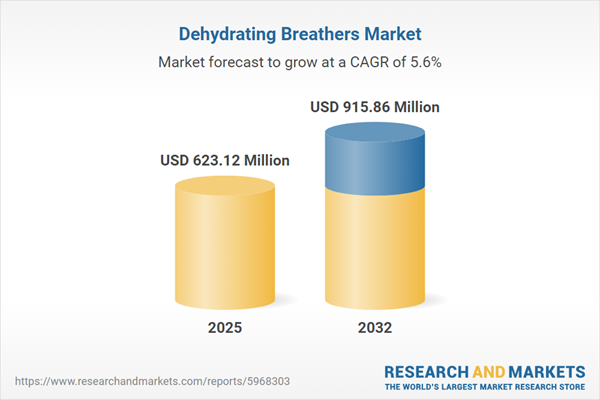Speak directly to the analyst to clarify any post sales queries you may have.
Senior executives seeking to protect critical assets and maintain compliance standards in demanding industrial, marine, and energy environments increasingly rely on dehydrating breathers. These systems are integral to sustaining operations, minimizing downtime, and facilitating proactive risk management amid evolving regulatory and operational complexities.
Market Snapshot: Dehydrating Breathers Market Size and Growth
The global dehydrating breathers market demonstrates steady expansion, currently valued at USD 590.37 million in 2024 and projected to reach USD 623.12 million by 2025. This upward trend is expected to persist, with forecasts indicating nearly USD 915.86 million by 2032 at a compound annual growth rate of 5.64%. Key drivers include enduring demand across essential industries, advancements in materials engineering, and rising integration of digital monitoring solutions in breather systems. Industry leaders are prioritizing innovation in research and development and enhancing supply chain robustness to keep pace with shifting operational requirements. These strategies help organizations extend equipment life and foster sustained business continuity.
Scope & Segmentation in the Dehydrating Breathers Market
This report offers a clear framework for strategic procurement and targeted investment, supporting decision-makers across multiple industries as regulations and technologies shift. Market segmentation addresses product diversity, user needs, technical materials, distribution pathways, and regional dynamics:
- Product Types: Combined breathers, desiccant breathers using either molecular sieves or silica gel, and systems incorporating pressure or vacuum controls for added flexibility.
- End Users: Industrial manufacturing, marine operations, power generation, oil and gas, and renewable energy, each presenting unique technical and compliance demands that call for specialized breather solutions.
- Material Types: Activated alumina, molecular sieves, silica gel, and zeolite—all offering reliable moisture control and suitability for harsh operating conditions.
- Distribution Channels: Direct sales, independent distributor networks, OEM placements, and digital ordering platforms facilitate diverse and resilient sourcing strategies.
- Regions: North America, Latin America, Europe, Middle East and Africa, and Asia-Pacific; local regulatory requirements and supply logistics significantly impact sourcing and compliance across these markets.
- Leading Companies Analyzed: Companies such as Donaldson Company, Parker-Hannifin, Eaton Corporation, MANN+HUMMEL, HYDAC, SKF, Des-Case, Filtration Group, Ingersoll Rand, and AAF International are evaluated for their emphasis on innovation, operational efficiency, and responsiveness to market shifts.
The inclusion of modular system designs and cutting-edge desiccants enables organizations to quickly adapt to regulatory shifts and address region-specific challenges. This approach adds value by improving maintenance flexibility and asset protection across diverse operating sites.
Key Takeaways for Senior Decision-Makers
- Integrating advanced dehydrating breathers increases equipment reliability and supports continuous operations while meeting stringent regulatory standards.
- Modular desiccant components help organizations adapt to evolving technical requirements and simplify maintenance routines, enhancing resource allocation.
- Efficient and transparent procurement channels empower leaders to navigate complex compliance obligations across multiple jurisdictions with greater certainty.
- Digital monitoring technologies within breather systems facilitate predictive maintenance and enable faster responses to potential disruptions.
- Partnering with specialized local suppliers aids adaptation to market- and region-specific procurement, regulatory, and logistics challenges during rollout and operation.
Tariff Impact: Navigating Sourcing and Operational Adjustments
Adjustments in global tariff policies are compelling many organizations to modify sourcing approaches, placing greater emphasis on nearshoring and the diversification of suppliers. Engineering teams are assessing alternative materials and refining assembly workflows to maintain system performance despite regulatory changes. Improved supplier collaboration, supported by active inventory management, enables more resilient and adaptable operational models as requirements continue to evolve.
Methodology & Data Sources
This market evaluation merges direct interviews with procurement and engineering specialists, input from distributors, technical field validation, and a breadth of secondary research. The result is robust, actionable guidance suited for strategic planning and enterprise-level decisions.
Why This Report Matters in the Dehydrating Breathers Market
- Equips executives with practical guidance to drive compliance and reinforce asset protection strategies in varied industrial applications.
- Supports adaptive sourcing methods aligned with complex regional regulatory landscapes and shifting tariff scenarios.
- Facilitates informed adoption of new breather innovations and streamlines procurement processes within intricate global supply networks.
Conclusion
This report delivers focused insights and concrete recommendations, strengthening operational resilience and compliance frameworks within the rapidly evolving dehydrating breathers market.
Additional Product Information:
- Purchase of this report includes 1 year online access with quarterly updates.
- This report can be updated on request. Please contact our Customer Experience team using the Ask a Question widget on our website.
Table of Contents
3. Executive Summary
4. Market Overview
7. Cumulative Impact of Artificial Intelligence 2025
Companies Mentioned
The companies profiled in this Dehydrating Breathers market report include:- Donaldson Company, Inc.
- Parker-Hannifin Corporation
- Eaton Corporation PLC
- MANN+HUMMEL GmbH
- HYDAC International GmbH
- SKF AB
- Des-Case Corporation
- Filtration Group Corporation
- Ingersoll Rand Inc.
- AAF International, LLC
Table Information
| Report Attribute | Details |
|---|---|
| No. of Pages | 199 |
| Published | November 2025 |
| Forecast Period | 2025 - 2032 |
| Estimated Market Value ( USD | $ 623.12 Million |
| Forecasted Market Value ( USD | $ 915.86 Million |
| Compound Annual Growth Rate | 5.6% |
| Regions Covered | Global |
| No. of Companies Mentioned | 11 |









